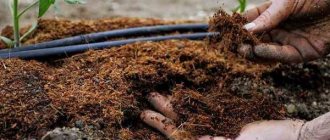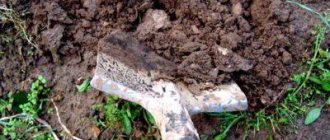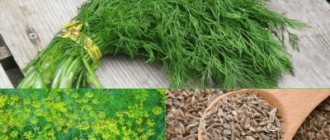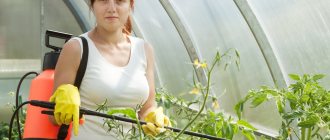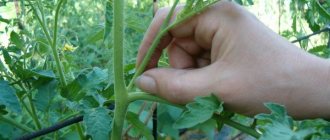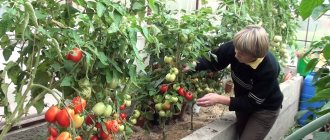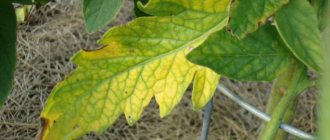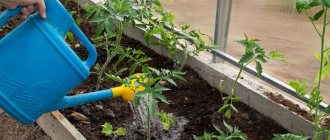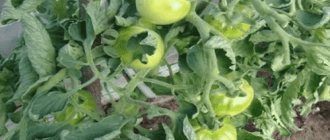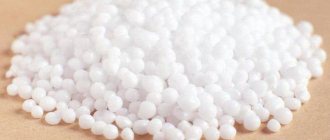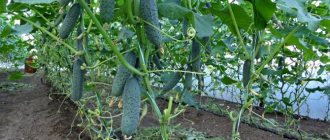As you know, tomatoes are planted in the spring, and the ground for them needs to be prepared in the fall. This is very important and no one should forget about it. The very first fertilizers for tomatoes need to be applied to the ground in advance, in the fall, so that the soil is saturated with the necessary components and becomes fertile. Thus, fertilizing the soil for tomatoes in the fall is the key to a good harvest in the summer. Today, there are a large number of different fertilizers that can improve the quality of fruits; the main thing is to follow the exact dosage instructions and time of application to the soil. With the help of autumn fertilizing, you can grow an excellent crop of tomatoes on soil that is not particularly fertile.
Preparing the soil in the fall for planting tomatoes
Latest articles about gardening
Pickling cabbage in February 2022 according to the lunar calendar
How to treat pepper seeds with hydrogen peroxide before planting seedlings?
Treating pepper seeds with potassium permanganate before planting seedlings
Autumn so as not to delay the fall plowing period. The best predecessors for tomato are cabbage and cucumber, under which high doses of organic fertilizers are usually applied. A day or two before planting the tomato, fertilizers (humus, superphosphate and potassium salt) are applied to the plot and it is again cultivated to a depth of 15-18 centimeters.
General concepts
Attention : Fertilizing is the application of mineral fertilizers during the formation, growth and development of plants. Fertilizing is periodic and, if properly organized, contributes to the growth of green mass in the plant, abundant flowering and fruiting, as well as successful wintering.
Fertilizer is the replenishment of nutrients lost in the soil after harvest . It is recommended to fertilize regularly, based on the calendar and the needs of the soil. Proper application of fertilizers helps reduce labor costs, increase soil fertility and crop yields.
What soil acidity is needed for planting tomatoes?
Tomato is not very sensitive to increased soil acidity. The acidity of cultivated soils is usually low (not lower than 5.5), so liming them is not advisable. If the acidity of the soil is high, then it is recommended to apply lime to the previous crops in the fall: cabbage, cucumber, onion. The optimal acidity of the medium for tomato is within the pH range of 5.0-6.0.
What ready-made products can you buy?
- Ammophos, nitroammophos, diammophos (contain nitrogen and phosphorus).
- Potassium nitrate (contains nitrogen and potassium).
- Calcium nitrate (contains nitrogen and calcium).
- Magnesium sulfate (composed of magnesium and sulfur).
- Potassium monophosphate (phosphorus-potassium fertilizer).
- Nitrophoska, nitroammophoska.
- Kemira Universal 2, Kemira Lux.
- Station wagon.
- Mortar.
- Tomato crystal.
There are other ready-made fertilizers for tomato seedlings, you can read about the most popular of them, such as “Athlete”, “Garden World” and others in this article, and here you will learn about such products as “Malyshok”, “Red” giant", "Mag Bor" and others.
Application of mineral fertilizers in autumn for planting tomatoes
Plants can absorb all useful substances from the soil only in the form of an aqueous solution. Therefore, many people prefer to use liquid complex fertilizers: they penetrate to the roots more quickly and, naturally, are absorbed faster by plants.
What else needs to be taken into account: mineral fertilizers applied in the fall should have a minimum nitrogen content; on the packaging of such compositions it is usually written: “autumn” or “for autumn use.” These mineral mixtures contain almost no nitrogen, but contain phosphorus, potassium, calcium - microelements necessary for the ripening of shoots, strengthening plant immunity, and increasing resistance to low temperatures. Information on the rate of fertilizer application can also be found on the packaging. You should not exceed it: it is better to underfeed than to overfeed.
A set of activities with greenhouse soils
The productivity of tomatoes in closed soil is several times higher than in open soil, and accordingly this imposes special requirements on greenhouse soils. The application of increased doses of fertilizers, elevated temperatures, intensity of cultivation, abundance of watering and repeated mechanical treatments entail increased requirements for the fulfillment of agrotechnical conditions.
Preparing the soil in a greenhouse in the fall for tomatoes depends on what type of technology you have chosen:
- Replaceable use of soils;
- Permanent use of soils.
If at the end of the fruiting season you rake everything out of the greenhouse, and in the spring you lay the soil mixture prepared in advance from the fall, then the issues of pests and pathogens, as well as fertility, are resolved radically.
In this case, after cleaning the area, the greenhouse is treated with a 1% solution of copper sulfate and opened to freeze during the winter. In the spring, soil mixture is delivered.
Applying organic fertilizers in the fall for planting tomatoes
They, in turn, are also divided into 2 groups: animal origin and plant origin. Plant fertilizers include composts and peat, and animal fertilizers include manure and poultry droppings. If you decide to use organic fertilizers, it is better to use compost. It is prepared quite simply: on an area of about 10 square meters. meters, straw is laid out 15 cm thick, then a layer of manure - 20 cm, a layer of peat - 15-20 cm. Phosphate rock and lime, mixed in a 1:1 ratio, are poured on top. For 1 sq. meter you need to sprinkle 50-60 grams of the mixture. A layer of manure 15-20 thick is once again poured on top. All layers are covered with a thin layer of soil and kept for 7-8 months. As for fertilizing with manure, in our time the number of cattle has decreased significantly, and therefore we have to look for an alternative. Anything that grows and rots can be used as products of plant origin for fertilizer: mown grass, fallen leaves, tops and weeds, etc.
Where to begin?
Ideally, plant debris should be removed immediately after the plant has finished fruiting. However, in practice it is not always possible to do just that. Therefore, cleaning up all leftovers is the main task.
If changing the soil is not part of your plans, green manure for tomatoes must be sown in the fall. The best green manure, regardless of what grew in the greenhouse this year, is mustard. This crop will quickly sprout, disinfect the soil, and by the onset of severe frosts it can be safely incorporated into the soil.
If crops are still delayed in some places, there is nothing to worry about. It is enough to lightly loosen the soil and it will perfectly accept mustard seeds. Shoots will appear quickly, and after a month the height of the plant will be sufficient for subsequent work.
Application of organic fertilizers in autumn for planting tomatoes
They are humic compositions of mineral and organic substances. Each drug is used individually, but there are general rules. For open soil, spraying is used, and for closed soil, surface watering, drip irrigation, sprinkling and manual spraying on the leaves are used. For seed treatment, use 300-700 ml of fertilizer per ton of seeds, for foliar feeding - 200-400 mm per 1 hectare of crops, for spraying - 5-10 ml per 10 liters of water, and for drip irrigation - 20-40 ml per 1000 liters of water for irrigation. Separately, it is worth mentioning plants that improve the soil. These include rapeseed, oilseed radish, rapeseed, turnip and others. Until recently, only lupine was used to improve the soil, which enriched the soil with nitrogenous mineral fertilizers, but recently other equally useful and effective plants have become known.
Disease Prevention
If crop rotation is used correctly with alternation of the main greenhouse crops over the entire area: pepper, cucumber, tomato, then the occurrence of pests and diseases is very unlikely. However, the realities of life are such that vegetable growers try to grow all the crops at once in one greenhouse, and even compact them with radishes, spinach, and cilantro. As a result, the likelihood of late blight increases.
It’s good if the fight against a pathogenic fungus began in early spring, then the spores are much smaller. If time is lost, then everything needs to be processed, preferably twice. Primary treatment should be carried out before sowing mustard. To do this, you can use the time-tested 1% solution of copper sulfate.
The remaining tomato tops are burned in the fall, and the soil, frames, and shelters are treated with a fungicidal solution. After sowing, growing, mowing mustard and adding additional ingredients, before digging, it is once again treated with a fungicide solution.
The use of sulfur bombs shows excellent results. Such treatment of a polycarbonate greenhouse in the fall against late blight will have the best effect on yields. The checkers are located along the perimeter of the structure and are set on fire, starting with the farthest one. Then the room is hermetically sealed. The checker itself “works” for up to 10 minutes, but the exposure (the time of hermetically sealing the room) must be maintained for 10 hours.
Restoring soil fertility after using chemicals
Chemicals kill beneficial microorganisms and bacteria. They begin to be restored a week after using the chemicals. To quickly restore microflora, use Baikal Em-1.
The liquid is prepared 5 days before processing. Add 40 ml of the drug and 4 tablespoons of honey to 4 liters of settled water, mix and cover with a lid. Leave the solution for 5 days and then water the soil with it. After chemical treatment, compost or humus is added to restore humus .
Soil fertility can be increased by solutions of potassium salts of humic acids.
Pollination
Tomatoes are self-pollinating plants that easily cope with this issue. Insects – bumblebees and bees – provide great assistance in the pollination process. To attract them to the site, you can plant such fragrant honey plants as mint, rapeseed, lemon balm, coriander, mustard, and basil.
In some cases, artificial pollination is required:
- Each bush is shaken a little.
- You can simply tap the blooming brush, but not too hard.
- This procedure is carried out in the first half of the day.
- After pollination is completed, you need to spray or water the tomatoes with warm water so that it flows over the flowers.
